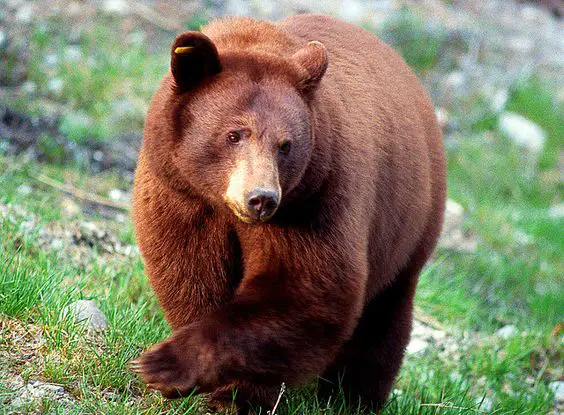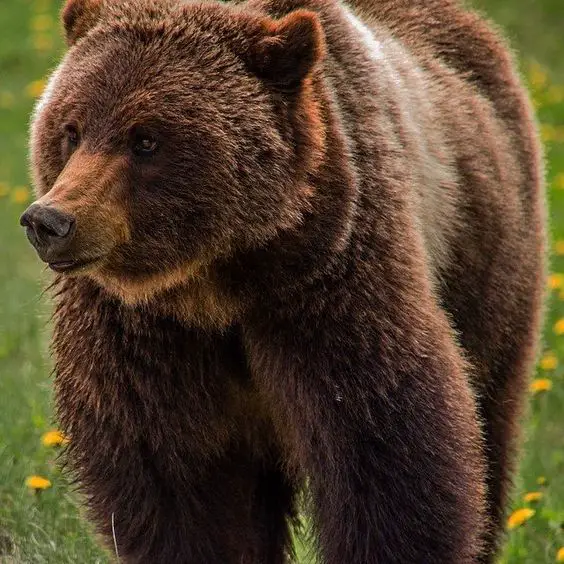An Overview of the Cinnamon Bear
The Cinnamon Bear is a subspecies of the American Black Bear famed for its unique reddish-brown fur, which resembles the color of ground cinnamon.

Native to the western regions of North America, particularly the Rocky Mountains and the United States’ northwest, these bears display characteristics that set them apart from their black bear kin.
Understanding the Cinnamon Bear is essential for wildlife enthusiasts, conservationists, and in ensuring the balance of ecosystems where these magnificent creatures roam.
Physical Characteristics of the Cinnamon Bear
Certain features distinguish Ursus americanus cinnamomum from other bear subspecies.
On average, these bears can weigh between 200 to 600 pounds, with males typically being larger than females.
The coat color ranges, but the most striking feature is their brownish-red fur which is where their name, Cinnamon Bear, is derived.
However, it’s their size that might be deceiving, as they share a similar stature with the standard American Black Bear.
Demystifying the Cinnamon Bear Habitat
Cinnamon Bears thrive in a range of habitats, from heavy forests
Access to a diverse diet and relative seclusion from human encroachment are key components for their ideal living conditions.
They are creatures of habit, tending to use the same paths and foraging spots seasonally.
Behavior and Lifestyle
Cinnamon Bears exhibit various behaviors that are fascinating to both researchers and observers.

They are generally solitary creatures, with females and their cubs being the most common grouping seen.
These bears are not true hibernators but enter a state of torpor during the winter months where their body temperature drops and metabolism slows down.
The Feeding Patterns of Cinnamon Bears
Though classified as omnivores, Cinnamon Bears have a diet that is heavily reliant on plant materials.
Berries, nuts, fruits, and vegetation make up a large part of their intake, with occasional forays into protein sources such as insects, fish, or carrion.
These feeding habits influence their size and health significantly.
Breeding and Reproduction
Mating season for Cinnamon Bears typically occurs during the spring and early summer months.
Females give birth during the winter denning period to cubs that are blind and helpless, weighing only a few pounds.
The cubs will stay with their mother for up to two years before venturing out to establish their own territories.
Conservation Status of the Cinnamon Bear
Currently, Cinnamon Bears, like all American Black Bears, are listed as a species of least concern by the IUCN.
However, their habitat is coming under increasing pressure from human expansion, leading to potential clashes and a need for cohabitation strategies.
Challenges Faced by the Cinnamon Bear
The growth of human populations encroaches on the territories historically roamed by Cinnamon Bears.

This leads to conflicts, habitat fragmentation, and road deaths, all of which pose significant risks to their populations.
What Are Some Bear Safety Tips?
When traveling in bear country, including regions inhabited by Cinnamon Bears, safety precautions are essential.
Making noise on trails, storing food properly, and understanding bear behavior can drastically reduce the chances of negative encounters.
Additionally, carrying bear spray and knowing how to use it can be a vital safety measure.
FAQs About the Cinnamon Bear
What distinguishes the Cinnamon Bear from other bear species?
Cinnamon Bears are a color phase of the American Black Bear, characterized by their distinctive reddish-brown fur, which resembles the color of cinnamon spice.
Where are Cinnamon Bears found?
They are primarily found in the western parts of North America, from the Rockies to the northwest United States, and occupy a variety of habitats including thick forests and mountainous areas.
What do Cinnamon Bears eat?
Their diet is mainly herbivorous, consisting of berries, nuts, fruits, and vegetation, although they will also eat insects, fish, and carrion.
Are Cinnamon Bears dangerous to humans?
Cinnamon Bears, like other wild animals, can be dangerous if threatened or provoked, especially when they feel their cubs are at risk.
However, with proper safety measures and respect for their space, negative encounters can usually be avoided.
Understanding Cinnamon Bear Interactions
When it comes to interactions, Cinnamon Bears, much like other American Black Bears, generally avoid human contact.
However, as developments encroach into their natural habitats, these bears are more likely to be observed by humans.
Encounters increase particularly during the seasons when natural food sources are scarce, leading bears to venture closer to human settlements in search of sustenance.
Adaptation Strategies of the Cinnamon Bear
As adaptable creatures, Cinnamon Bears have developed behaviors that allow them to thrive in various environments.

Their ability to forage for a wide range of foods and to exploit diverse habitats makes them resilient to changes within their ecosystems.
For example, they are known to increase their intake of calorically dense foods like nuts in preparation for the winter months, a behavior that showcases their innate ability to adapt to seasonal shifts.
Human and Cinnamon Bear Cohabitation
Efforts are being made to promote the cohabitation of Cinnamon Bears and humans, minimizing potential conflicts while ensuring the conservation of the species.
Education on bear behavior, proper food storage in campgrounds, and bear-proof trash receptacles are some of the measures contributing to this goal.
Clear guidance and regulations within bear habitats can facilitate peaceful coexistence, where both bears and humans can appreciate the value of natural, shared spaces.
The Influence of Climate on Cinnamon Bear Behavior
Climate and seasonal changes have significant impacts on the behavior of these bears.
During dry spells or warmer winters, Cinnamon Bears may not enter torpor as they would in colder climates, which could affect their foraging patterns and interaction with humans.
An understanding of these changes is vital for wildlife management and the development of adaptive conservation strategies.
Cinnamon Bears in Culture and Media
Cinnamon Bears have made appearances in popular culture and media, often featured as the subject of documentaries and educational programs.
Their distinct coloring and presence in public parks and wilderness areas across the western United States have made them a recognizable subspecies within the American Black Bear family.
They are also symbols for various conservation campaigns, advocating for the protection of bear habitats and wildlife awareness.
Viewing Cinnamon Bears in the Wild
If you’re interested in observing Cinnamon Bears in their natural habitat, several locations across North America are renowned for their sightings. Here are some specific areas you might consider:
- Pocosin Lakes National Wildlife Refuge, North Carolina – Known for its rich biodiversity, this refuge offers a chance to see Cinnamon Bears, particularly in the Pungo Unit. The area is accessible by car, and it’s recommended to visit during early morning or late afternoon for the best wildlife viewing opportunities (Misadventures with Andi).
- Western North America – Cinnamon Bears can be found throughout this region, especially in areas with dense forests and mountainous terrain. Key states include Alaska, British Columbia, California, Colorado, Montana, Idaho, and Wyoming. These bears thrive in diverse habitats from riparian zones near rivers, where they may catch salmon, to forested areas where they forage on berries and nuts (Worldwide Nature – Q&A About Nature).
- National Parks – National parks such as Katmai National Park and Preserve offer structured viewing platforms and guided tours that increase the likelihood of seeing bears in a safe and respectful manner. These parks also emphasize conservation and provide educational insights into the lives of Cinnamon Bears (NPS.gov).

It is important for visitors to these areas to maintain a safe distance and to follow guidelines set by park rangers and wildlife professionals.
Ensuring that these encounters are safe and non-intrusive is key to respecting the Cinnamon Bear’s right to a secure and undisturbed life.
Research and Monitoring of Cinnamon Bear Populations
Active research and ongoing monitoring are crucial for tracking the health and trends within Cinnamon Bear populations.
Through scientific studies, wildlife biologists can make informed decisions about conservation efforts and management practices needed to support their survival.
Technologies like GPS collaring and remote cameras assist in collecting valuable data on bear movements, habitat use, and population dynamics.
Cinnamon Bears and Ecosystem Health
Cinnamon Bears play a pivotal role in maintaining ecosystem health through their interactions in the food web.
By controlling insect populations and facilitating seed dispersal through their scat, they contribute to the biodiversity and vitality of their habitats.
Understanding the broader implications of their ecological role helps in realizing the importance of Cinnamon Bears beyond their aesthetic appeal.
Potential Threats from Invasive Species and Diseases
Beyond human encroachment, invasive species and diseases also pose threats to Cinnamon Bear populations.

Introducing non-native species can disrupt the balance of native ecosystems, while diseases can spread rapidly, affecting both individual bears and entire communities.
Conservation efforts often involve measures to protect against these dangers, ensuring the long-term health and prosperity of Cinnamon Bears.
What to Do if You Encounter a Cinnamon Bear?
If you do find yourself face-to-face with a Cinnamon Bear, there are important steps to follow to ensure your safety.
Remain calm, avoid direct eye contact, and slowly back away while speaking softly to identify yourself as a human and not a prey animal.
Understanding bear behavior can help you respond appropriately in such situations, and it’s always best to be prepared with bear spray as a non-lethal deterrent.
How can Cinnamon Bears and humans coexist?
Coexistence requires a mutual understanding and respect for the boundaries and needs of both species.
Why is it important to study Cinnamon Bear behavior?
Studying these bears provides valuable insights into their survival strategies, informs conservation policies, and ensures the protection of their natural habitats.
How can climate change affect Cinnamon Bear populations?
Changing weather patterns can alter hibernation cycles, foraging behaviors, and ultimately the sustainability of bear populations within their current habitats.


